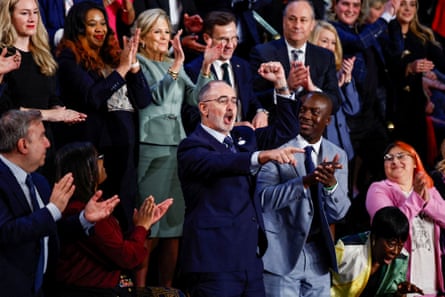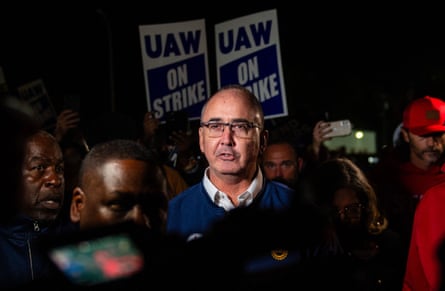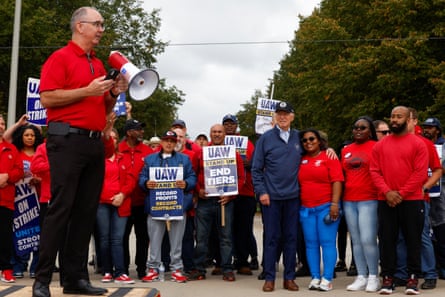From Amazon and UPS to Starbucks and Hollywood studios, organized labor is making a comeback in the US after decades of decline. Shawn Fain thinks he knows why: “Workers have realized they’ve been getting screwed for decades, and they’re fed up.”
The United Auto Workers (UAW) president has emerged at the front of the pack of a new generation of labor leaders as a galvanizing voice in a critical year for the labor movement and American politics.
A soft-spoken but unrelentingly blunt midwesterner, Fain has met the moment in his role as the union’s newly elected president. Having beaten the US’s big three automakers into a landmark new union contract, Fain’s members have been courted by both Joe Biden and Donald Trump. Fain has gone all in for the Democrats despite some reservations and the misgivings of some of his members.
Now he faces bigger tests. The UAW is taking its fight to states that have long, successful records of seeing off union drives – and he must hold his new coalition together as the US enters a fractious election cycle that will pit worker against worker.
The union boss’s political ascendancy was crowned by his recent appearance as a guest at Joe Biden’s State of Union address, where both he and the union were called out in a nationally-televised salute from the commander-in-chief.
Sporting a new, closely cropped beard and wearing a dark business suit and tie for the Capitol occasion, Fain responded with a raised power fist, telegraphing in one succinct image how much organized labor’s message and tone have changed of late, along with their popularity.

The winning trajectory of the union and its new, class-conscious president have caught carmakers off guard, no more so than when Fain, 55, contrasts his workers’ declining wages with corporate share buybacks and the lavish compensation bestowed upon automotive CEOs.
Not without irony, Fain’s ascent almost certainly wouldn’t have been possible but for the 2022 federal felony convictions of more than a dozen union officials, as well as three Stellantis executives, for fraud and corruption, including embezzlement of union training funds. A UAW dissident with near 30 years’ previous service as a Stellantis (formerly FCA and Chrysler) electrician in Kokomo, Indiana, Fain unseated the union’s long-entrenched leadership cabal in 2023, vowing to root out corruption and change what he viewed as the union’s overly accommodating posture toward their employers.
Speaking recently with the Guardian in his office at the UAW’s Detroit headquarters – Solidarity House, a brutalist four-story structure built in the 1950s along a grim stretch of East Jefferson Avenue, overlooking the Detroit River – Fain without naming names derided previous leadership. “The corruption was one thing. But even prior to that. What they call ‘working together’, I call ‘company unionism’. All we witnessed out of that philosophy is losing plants, losing jobs. We watched over 20 years as 65 factories [owned by] the big three, disappeared. ‘Working together’ in the spirit of what I view it as would be when it’s a win-win for everybody. It’s not one-sided.”

Fain was a national bargaining negotiator during the Great Recession and the 2009 Chrysler bankruptcy. “I saw how the company really went after everything, took advantage of a bad situation while our workers bore the brunt of all that sacrifice. Moving forward, we’ve sat here for over a decade, watching the big three make massive profits. I ran for this reason, to change this union, to get us back to what it is supposed to be and hasn’t been in my lifetime. Right from the beginning, we had to set the tone and do things differently. We ran the contract campaign to define the narrative and define the issues. In the last decade, the [big three] companies made a quarter trillion dollars in profits. CEO pay went up 40% in the last four years. And our pay went backwards. So that was really setting the table.”
Cleaning house at the union’s headquarters, Fain brought in new staff experienced in the use of social media, something that helped galvanize his campaign to lead the UAW. “I didn’t have the advantages that [predecessors] had because they were in power. They could fly all over the country on the union’s dime and visit plants under the guise of union business. People like me who were running had to take vacation [time] and go stand out at plant gates and hope to catch workers coming and going.”
Fain turned to social media to interact with members all over the country. “We were doing this as a way to communicate with our members. But it turned into a lot more because social media brought in anyone that wanted to come in. The general public was paying attention, the news media paid attention. And I think it was really effective because when it got time to go on strike, 75% of Americans supported us.”
The big three were caught flat-footed by the fresh approach. “I think they just thought that it was talk,” Fain said. “They’re used to hearing talk. Companies were used to having their way, saying what they wanted and getting it. I don’t think they really knew how to handle leadership that wasn’t operating in that mode. I mean, our leaders in the past, they’d stand up and beat the podium and say, ‘We’re gonna fight, we’re gonna fight, fight, fight!’ and then when they got into negotiations, they’d roll over. Obviously, I don’t think they expected this and, let’s be honest, they didn’t expect me to be president.”

Breaking with precedent, where just one of the trio of American legacy makers would be “targeted” for a strike, the UAW launched simultaneous strikes against all three, then shrewdly conserved strike funds by closing individual plants rather than all at once. The 46-day “Stand Up Strike,” begun after contract negotiations with General Motors, Ford and Stellantis collapsed, ended in a resounding victory for the UAW. Since then, with the wind at its back, the union has taken the fight to the many non-union auto manufacturing plants dotting the country, including many in southern, so-called “right to work” states.
News last month that 96% of unionized workers at Daimler Trucks North America plants in North Carolina, Georgia and Tennessee voted to authorize a strike should ongoing negotiations fail to yield a satisfactory replacement for a contract expiring in April, brought fresh evidence that the record gains in its 2023 campaign against the big three have drastically altered the wider industry’s state of play. So did the UAW’s successful drives to have elections held at Volkswagen’s Chattanooga, Tennessee, and at Mercedes-Benz’ Vance, Alabama plants.
Fain is bullish on the possibility of extending the union’s gains to non-union automobile factories. Notable among the Detroit settlements’ broader impact has been how, in efforts to avert unionization, several non-union carmakers, including Toyota, Honda, Tesla, Nissan, Subaru, Volkswagen, and Hyundai hurried to give workers unsolicited raises and, in some cases, improved benefits and eliminated the two-tier wage structures, where new hires, often classified as temporary, are paid substantially less than veteran workers.
Fain said he believes these companies all have more to give, as does Tesla, which, despite recent share losses, has been one of the world’s most profitable makers of electric vehicles. Elon Musk, the company’s CEO, is a vociferous foe of unionization. Recently, following a complaint filed against his SpaceX company, the rocket and satellite maker joined Amazon, Starbucks and Trader Joe’s in suing the NLRB, challenging the constitutionality of the almost 90-year-old agency.

Fain’s overarching optimism is grounded, he insists. “Workers have realized they’ve been getting screwed for decades, and they’re fed up … If Volkswagen workers had Ford’s [new] agreement, they would have got $23,000 profit-sharing checks this year. Instead, they got zero … We made a big deal in the big three contract fight that these companies made a quarter trillion dollars in profits in the last decade. But the Japanese and Korean six [with US factories] made $480bn. The German three made $460bn in profits worldwide. Toyota alone made $256bn profit in the last decade. Their profit margins are obscenely more gross than they were at the big three, and yet their workers get less. I truly believe we’re going to see a huge shift this year. I think we’re gonna win in the south.” And Musk? A somewhat tougher nut to crack, Fain concedes, adding: “He’s the epitome of everything that’s wrong with this world.”
Not one to mince words, Fain’s bold rhetoric harkens to a long-gone era, his regular use of stark terms like “billionaire class” recalling, for this reporter, childhood remembrances of elderly trade unionist relations recounting 1930s Labor Day marches down New York’s Fifth Avenue. Fain credits his old-school class consciousness to the experience of his grandparents – poor people who emigrated from the south during the Depression to the north to work in the newly unionized automobile industry, affording them a middle-class life. He also notes the importance of his faith. An unthinking churchgoer as a youth, he said adulthood brought a renewed interest in religion. “I started reading the Bible. I pray every day when I wake up. I do a daily reading. And everything I read about it, no matter what religion someone is, whether you’re Muslim or Christian, whatever your belief is, all religion speaks to one thing, it’s love of your fellow human being. With the greatest excess in the history of the world, why don’t we work with a mindset of what works for human beings?”
What he doesn’t have faith in is the likelihood that corporations will use technology to make life better for his members. “[Legendary UAW leader] Walter Reuther [who died in a 1970 plane crash] had this famous saying, ‘We have to master technology, not let it master us,’” said Fain.
“As we have advancements in technology, it should be making life easier for people and workers’ lives. But what happens? When technology advances, the companies find ways to eliminate jobs, close plants, exploit workers in other places. And then the people that are left with a job, they want them to work longer and harder … The companies have to realize they’ll still make their profits; government should be subsidizing some of this. And everyone wins in this equation. Workers have better lives, working class people have better lives. The companies are profitable. The money’s there. This can all happen but let’s go back to the central issue of this. It’s corporate greed and a miniscule amount of people, the billionaire class, who want to concentrate all the wealth in their hands and screw everybody else to do it.”

Fain objects strongly to those who would place the blame for rising car prices on union contracts. “Another myth. Five to 7% of the cost of a car is labor. [Carmakers] could give us everything they gave us in that contract and not raise the price of cars a penny and still make massive profits. Why are they not saying what $20 billion in [additional] corporate dividends and stock buybacks cost them? That affects the bottom line more. That money somehow just disappears and doesn’t count, right? All they want to talk about is our wages and our benefits. People forget, over the last four years, the price of vehicles went up 35% on average. But our wages didn’t go up. Our benefits didn’t get better. Nothing changed for us. [Price hikes are] because of two things: corporate greed and consumer price gouging. They just pile all those costs on and then try to blame the workers for it.”
A latter day rise in the union’s long-sagging fortunes – its membership dwindled from 1.5m in the 1970s to its current 380,000 – has been seen by some hopeful observers as early evidence of a burgeoning reversal of the downward trend that began with the punishing defeat of the air traffic controllers’ union early in the Reagan administration. In hindsight, Fain, who was a teenager at the time, suggests “all labor, not just union labor, should have come together then. I wish they would have. Because what’s happened over the last 40 years? Reagan and the ‘greed is good’ idea and the new philosophy of the rich getting richer. Forty years of going backwards for the working class … people understand that they’ve been left behind. Workers are now scraping to get by, while working multiple jobs, seven days a week, 12 hours a day and living paycheck to paycheck. That’s not a life. When I was a kid it didn’t matter if you worked at a grocery store, or if you worked at an assembly plant, a one-person income could sustain a family. That’s not the case anymore … workers, union and non-union, have to harness the power that we have and take back our lives.”
Asked about the parallels between Reagan and Trump, charismatic presidents who quietly championed the interests of wealth and organized capital while retaining a strong following among the working class, Fain acknowledged the undeniable presence of a voluble Maga contingent among autoworkers including members of his own union. But he played down the political division within the ranks.
Trump, a lifelong anti-union voice, has singled out the labor organization and Fain, in particular, for derision. Calling the union corrupt and Fain “a weapon of mass destruction” for jobs, Trump traveled to Detroit during the high-profile strike to a staged rally purportedly in support of auto workers but opposed to the union. Held at a non-union plant that charged his campaign $20,000 for its use, the event featured a crowd containing no actual auto workers, anti-union or otherwise.
In January, Fain, who has said Trump represents the billionaire class and “doesn’t give a damn about working-class people” endorsed Biden’s re-election bid on the union’s behalf. “As I tell our members, ‘Look, this isn’t a Democrat-Republican issue. This isn’t a party issue. This wasn’t my opinion. Let’s look at their own words and their own actions.’” Fain credits Biden and Democrats with the federal government’s rescue of the domestic industry during the 2008-2009 recession, as the newly-installed Obama administration pro-actively addressed the bankruptcies of GM and Chrysler. “They worked on a path forward for [the US car business] to come out of this and to live, they battled for the American worker. Trump, at the same time, was blaming the workers for everything that was wrong with these companies.”
Last Fall “[f]or the first time in American history, a sitting US president [Biden] joined workers on the picket line. Trump had that opportunity in 2019, when GM was on strike for 40 days. He never said a word about the strike. He never did a damn thing to support it.”
Auto worker support could well be critical in determining the allegiance of Michigan’s electoral college delegates, as well as those in other swing states. There’s no doubting where Fain thinks their best interest lie. “Joe Biden has a lifelong history of serving others and in standing with working-class people. President Trump has a lifetime history of serving himself and the billionaire class. And so there’s a stark contrast there. When you look at those things, the decision for us is very easy about who has our interests at heart. And who doesn’t. Sure, some of our members are still going to vote for Trump. But at the end the day we have to put the facts out there, we have to talk to our members about that and hope like hell we don’t have another disaster for four years.”
